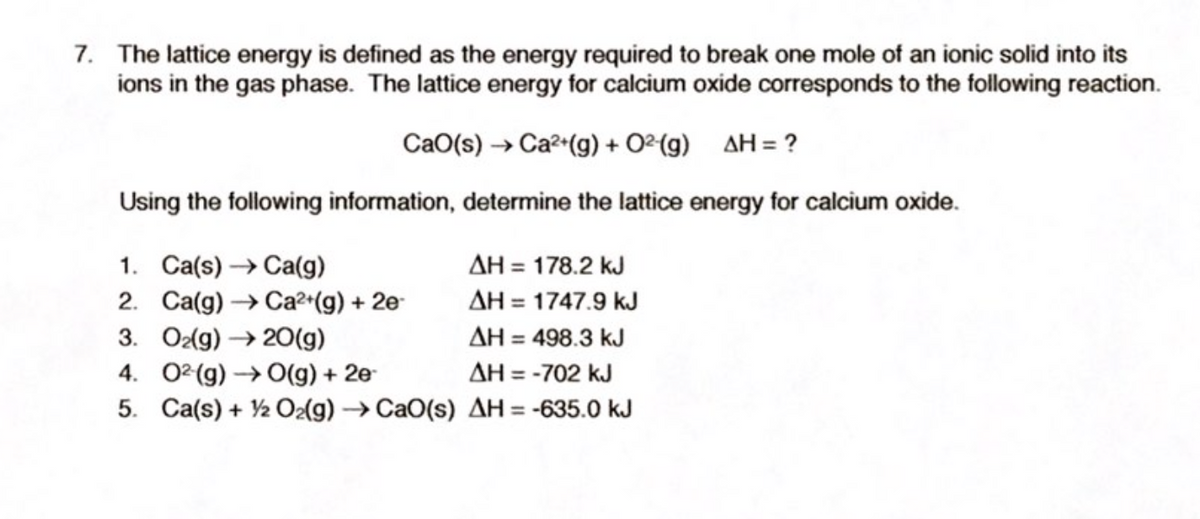7. The lattice energy is defined as the energy required to break one mole of an ionic solid into its ions in the gas phase. The lattice energy for calcium oxide corresponds to the following reaction. CaO(s) → Ca2-(g) + O²(g) AH = ? Using the following information, determine the lattice energy for calcium oxide. AH = 178.2 kJ AH = 1747.9 kJ 1. Ca(s) → Ca(g) 2. Ca(g) → Ca²•(g) + 2e- 3. Oz(g) → 20(g) 4. 02 (g) → O(g) + 2e 5. Ca(s) + 2 O2(g) → CaO(s) AH = -635.0 kJ AH = 498.3 kJ AH = -702 kJ
7. The lattice energy is defined as the energy required to break one mole of an ionic solid into its ions in the gas phase. The lattice energy for calcium oxide corresponds to the following reaction. CaO(s) → Ca2-(g) + O²(g) AH = ? Using the following information, determine the lattice energy for calcium oxide. AH = 178.2 kJ AH = 1747.9 kJ 1. Ca(s) → Ca(g) 2. Ca(g) → Ca²•(g) + 2e- 3. Oz(g) → 20(g) 4. 02 (g) → O(g) + 2e 5. Ca(s) + 2 O2(g) → CaO(s) AH = -635.0 kJ AH = 498.3 kJ AH = -702 kJ
Chemistry: Principles and Practice
3rd Edition
ISBN:9780534420123
Author:Daniel L. Reger, Scott R. Goode, David W. Ball, Edward Mercer
Publisher:Daniel L. Reger, Scott R. Goode, David W. Ball, Edward Mercer
Chapter5: Thermochemistry
Section: Chapter Questions
Problem 5.78QE
Related questions
Question
Based on Question 7 from The Additivity of Heats (Hess's Law) Worksheet, what is the calculated value (kJ) for the Lattice Energy of CaO? Do not type units into your answer.

Transcribed Image Text:7. The lattice energy is defined as the energy required to break one mole of an ionic solid into its
ions in the gas phase. The lattice energy for calcium oxide corresponds to the following reaction.
CaO(s) → Ca²•(g) + O²(g) AH= ?
Using the following information, determine the lattice energy for calcium oxide.
AH = 178.2 kJ
AH = 1747.9 kJ
1. Ca(s) → Ca(g)
2. Ca(g) → Ca²*(g) + 2e-
3. Ozlg) → 20(g)
4. 02 (g) → O(g) + 2e
5. Ca(s) + 2 O2(g) →CAO(s) AH = -635.0 kJ
AH = 498.3 kJ
AH = -702 kJ
Expert Solution
This question has been solved!
Explore an expertly crafted, step-by-step solution for a thorough understanding of key concepts.
This is a popular solution!
Trending now
This is a popular solution!
Step by step
Solved in 2 steps with 2 images

Knowledge Booster
Learn more about
Need a deep-dive on the concept behind this application? Look no further. Learn more about this topic, chemistry and related others by exploring similar questions and additional content below.Recommended textbooks for you

Chemistry: Principles and Practice
Chemistry
ISBN:
9780534420123
Author:
Daniel L. Reger, Scott R. Goode, David W. Ball, Edward Mercer
Publisher:
Cengage Learning

Chemistry: The Molecular Science
Chemistry
ISBN:
9781285199047
Author:
John W. Moore, Conrad L. Stanitski
Publisher:
Cengage Learning

Chemistry
Chemistry
ISBN:
9781305957404
Author:
Steven S. Zumdahl, Susan A. Zumdahl, Donald J. DeCoste
Publisher:
Cengage Learning

Chemistry: Principles and Practice
Chemistry
ISBN:
9780534420123
Author:
Daniel L. Reger, Scott R. Goode, David W. Ball, Edward Mercer
Publisher:
Cengage Learning

Chemistry: The Molecular Science
Chemistry
ISBN:
9781285199047
Author:
John W. Moore, Conrad L. Stanitski
Publisher:
Cengage Learning

Chemistry
Chemistry
ISBN:
9781305957404
Author:
Steven S. Zumdahl, Susan A. Zumdahl, Donald J. DeCoste
Publisher:
Cengage Learning

General Chemistry - Standalone book (MindTap Cour…
Chemistry
ISBN:
9781305580343
Author:
Steven D. Gammon, Ebbing, Darrell Ebbing, Steven D., Darrell; Gammon, Darrell Ebbing; Steven D. Gammon, Darrell D.; Gammon, Ebbing; Steven D. Gammon; Darrell
Publisher:
Cengage Learning

Chemistry & Chemical Reactivity
Chemistry
ISBN:
9781337399074
Author:
John C. Kotz, Paul M. Treichel, John Townsend, David Treichel
Publisher:
Cengage Learning

Chemistry & Chemical Reactivity
Chemistry
ISBN:
9781133949640
Author:
John C. Kotz, Paul M. Treichel, John Townsend, David Treichel
Publisher:
Cengage Learning